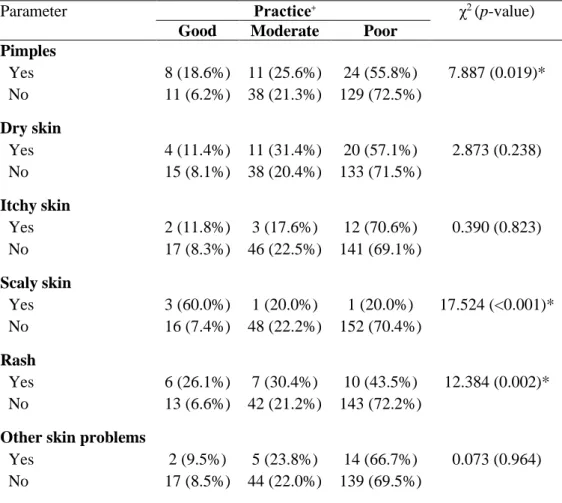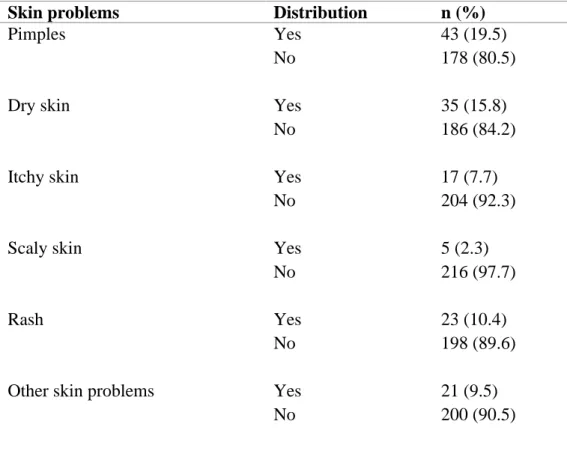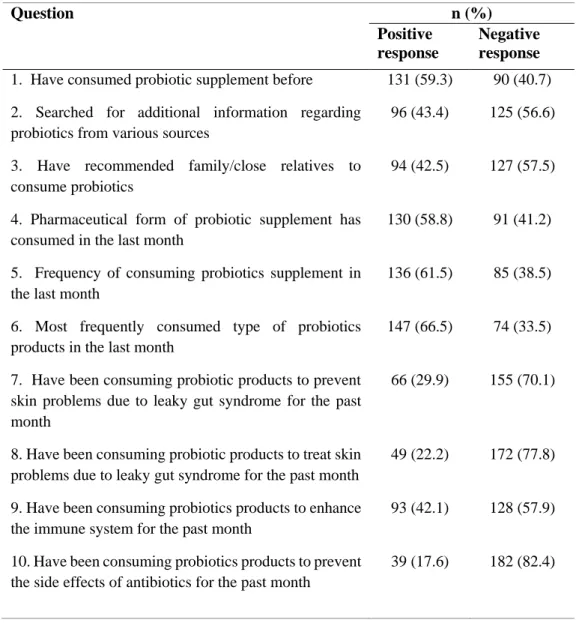ASSESSMENT OF KNOWLEDGE, ATTITUDE AND PRACTICE TOWARDS PROBIOTICS FOR THE GUT-SKIN AXIS AMONG HEALTH SCIENCE GRADUATES IN MALAYSIA. Respondents demonstrated a good level of knowledge, moderate attitude and poor practice towards probiotics for the gut-skin axis.
Background study
Despite numerous studies conducted on the possible health benefits of probiotics, there have been insufficient studies on the factors influencing the use of probiotics (Arshad et al., 2021). Consumers in Malaysia are aware of probiotic supplementation, but the knowledge about the use of probiotics was remarkably low (Chong and Teh, 2020).
Significance of study
As a future health care professional, the KAP of probiotic use for health science graduate students should be carefully evaluated and well understood. 3 included in the undergraduate health sciences curriculum for knowledge and best practices regarding the use of probiotics.
Objectives
General objective
It could also be beneficial for advanced researchers who aimed to study the use of probiotics in the treatment or prevention of skin disorders.
Specific objectives
Prevalence of skin problems
Role of probiotics
Consequently, it helps to strengthen epithelial integrity and improve immune tolerance in the host's body (Levkovich et al., 2013). Oral intake of probiotics may also be beneficial in strengthening skin barrier function by reducing trans-epidermal water loss (TEWL) and increasing corneal hydration (Ogawa et al., 2016).
Skin and gut microbiome
7 circulatory system through which anti-inflammatory and immunomodulatory effects are exerted (Maslowski et al reported that SCFAs play a critical role in influencing the predominance of certain skin microbiota, which influences the skin's innate immune system. In addition, the relationship between the gut-skin axis may be good -explained when celiac patients with dermatitis herpetiformis had achieved healing of the small intestine and their skin lesions had resolved after strict adherence to a gluten-free diet (Collin et al., 2017).
Knowledge about probiotics
Apart from that, Arshad et al. 2021) reported that 15.1% of the participants had good knowledge about probiotics. While the majority of health science students in Indonesia also had acceptable knowledge about probiotics.
Attitude towards probiotics
However, 88.5% of health science students agree that they want to study more about probiotics. These findings showed that most respondents liked to learn about probiotics and their mechanism of action.
Practice on probiotics
According to Arshad et al. 2021), there were only 15.6% of healthcare professionals who had good practice regarding the use of probiotics. The low practice level of probiotic use may be due to poor knowledge of probiotics among the healthcare professionals.
Association of KAP towards probiotics
14 Furthermore, the research carried out by Arshad et al. 2021) also showed that a good level of knowledge about probiotics was associated with good practice of probiotic use.
Study design
Inclusion and exclusion criteria
The all-choice question was awarded 1 point if all correct answers were selected. Each positive response was awarded a score of 1 point and 0 points for a negative response, except for “frequency of probiotic supplementation.
Data collection
Statistical analysis
Pearson's Chi-Square test of association was performed to study the association between skin problem and KAP variables among the respondents. Therefore, the statistical difference between KAP variables between sociodemographic factors was tested using one-way analysis of variance (ANOVA) and Tukey's Honest Significant Difference test as post-hoc test. Independent t-test was used to examine the difference between KAP variables between male and female students.
The correlation coefficient was outlined in Table 3.1, which indicates the strength of the relationship between the variables (Abu Bakar et al., 2021).

Characteristics of the respondents
Knowledge of probiotics
In addition, 95.5% of respondents selected the right types of probiotics that are commonly used in probiotic production. Also, 50.2% of respondents disagreed that probiotics could be used in the treatment of skin problems caused by leaky gut syndrome. In particular, 85.1% of respondents strongly agreed that they would like to learn more about probiotics.
More than half of the respondents (82.4%) reported consuming probiotic products that were not intended to prevent side effects of antibiotics.
Level of knowledge, attitude and practice towards probiotics
Have used probiotic products in the past month to prevent skin problems due to leaky gut syndrome. Have been using probiotic products for the past month to treat skin issues due to leaky gut syndrome. Have used probiotic products for the past month to avoid the side effects of antibiotics.
The majority of respondents (69.2%) had poor practices towards probiotics, while 8.6% and 22.2% of respondents had good and moderate practices towards probiotics, respectively.
Difference between sociodemographic on KAP variables
Sociodemographic differences towards the knowledge of probiotics The sociodemographic differences towards the knowledge, attitude and practice
These findings showed that knowledge about probiotics was significantly higher in the fourth year of study compared to the first and second year of study. A medical student (M=9.74, SD=1.48) has the highest average knowledge score among other health sciences students. These findings showed that the attitude towards probiotics in the fourth year of study (M=23.44, SD=2.06) was higher compared to other years of study.
The results indicated that the nursing students (M=23.33, SD=1.97) scored better than the other health science students in the attitude component.
Sociodemographic differences towards the practice of probiotics According to Table 4.7, there was no significant difference in practice score of
Findings showed that health science students with CGPAs of 2.5 to 2.99 performed significantly worse than other groups with a range of CGPAs. These findings showed that nutrition students performed significantly worse than medical and pharmacy students in practical work.
Association between skin problems and KAP variables
Association between knowledge of probiotics with skin problems Table 4.8 shows the association between knowledge of probiotics with skin
Association between attitude towards probiotics with skin problems Table 4.9 shows the association between attitude towards probiotics with skin
Association between practice towards probiotics with skin problems Table 4.10 shows the association between attitude towards probiotics with skin
There was a statistically significant moderate correlation between knowledge-attitude (r=0.48, p<0.001) and knowledge-practice (r=0.42, p<0.001) variables.

Knowledge of probiotics
Knowledge components of questionnaire
However, more than half of the respondents (58.8%) were not familiar with the use of probiotics in improving the skin barrier by reducing TEWL. It also underscores the need for more evidence-based instructional and practical materials on the application of probiotics to the gut-skin axis. It can be deduced that most respondents have not learned about the mechanism of probiotics in regulating the host immune response.
Research has shown that the administration of probiotics can prevent the disruption of tight junction proteins by lowering the number of lipopolysaccharides (LPSs).
Knowledge of probiotics among gender and ethnicity
Despite a lack of probiotics studies on the ethnicity parameter, the fact that an asymmetric number of respondents between the three races can be explained led to an atypical result. Therefore, further studies are needed to confirm the link between probiotic knowledge and ethnicity.
Knowledge of probiotics among age group and year of study
In addition, the result in this study indicated that medical students (M=9.74, SD=1.48) scored better than the other undergraduate programs in the knowledge component, although the findings were not statistically significant. These findings paralleled those of Soni et al. 2018), as the knowledge score of probiotics among medical students was significantly higher than nutrition students, while medical students scored better than pharmacy students, although it was not statistically significant. 2021) reported that medical students had better knowledge of probiotics compared to pharmacy and nursing students, although this was not statistically significant.
This may mean that medical students receive much more well-rounded health education than their colleagues.
Attitude towards probiotics
- Attitude components of questionnaire
- Attitude towards probiotics among gender and ethnicity
- Attitude towards probiotics among age group and year of study The findings in this study also indicated that age group of 21 to 23 years had
- Attitude towards probiotics among CGPA
However, this result is not parallel to a study conducted by Rahmah et al. 2021), as 51.7% of respondents have a neutral attitude towards the ability of probiotics to prevent side effects of antibiotics. This result is congruent with (Rahmah et al., 2021), as the majority of respondents (88.5%) would like to know more about probiotics. The result can be compared with a study conducted by Arshad et al. 2021), as the female health professionals (56.6%) had a more positive attitude towards probiotics than the male health professionals (43.5%).
This result is comparable to Arshad et al. 2021), as there was no significant relationship between attitude towards probiotics and year in practice.
Practice towards probiotics
Practice components of questionnaire
The current study revealed that almost half of the respondents (59.3%) had consumed probiotic supplements, but half of them (56.6%) reported that they did not search for additional information regarding probiotics. Notably, our study revealed that the majority of respondents consumed probiotic supplements that were not intended to prevent (70.1%) or treat (77.8%) skin problems due to leaky gut syndrome. From the survey, female respondents generally had better practices on probiotics use compared to male respondents, although the result was not statistically significant.
Further research is therefore required to establish the association between probiotic practice and ethnicity.
Practice on probiotics use among age group and year of study Present study revealed that there was no significant difference between the age
This result is parallel to Arshad et al. 2021), as male respondents performed worse in practice than female respondents, although the result was not statistically significant. Several studies had shown that the use of health supplements was more prevalent among women compared to men (Dickinson and Mackay, 2014; Sotoudeh et al., 2015). Furthermore, the present study reported that Indian respondents (M=6.65, SD=4.03) have better probiotic practice scores than other counterparts, although the results were not statistically significant.
This result is not parallel to Arshad et al. 2021), as there was no significant association between probiotic practice and year in practice.
Practice on probiotics use among undergraduate programme Furthermore, the present study indicated that the nutrition students (M=4.15,
These differences may be due to the fact that the current study had a lower number of respondents in fourth years of study (n compared to the peers, and can therefore easily influence the proportion in practice level in fourth years of study variable.
Practice on probiotics use among CGPA
60 GPA was negatively associated with consumption of fast food, soft drinks and alcohol (Deliens et al., 2013). Another study conducted by Kobayashi (2009) also revealed that there was a negative relationship between academic performance and fast food consumption observed in both American college students and Japanese college students.
Practice on probiotics use among skin problems
Nevertheless, these findings are consistent with a research from India that found that healthcare professionals' attitudes and knowledge of probiotics influence their current practice (Soni et al., 2018). Most respondents were also skeptical about the application of probiotics as an adjunct for the management of skin disorders. Assessment of the awareness and knowledge about the use of probiotics by health professionals in Nigeria.
Assessment of the knowledge and perception of probiotics among medical science students and practitioners in Lagos State. Anti-inflammatory and immunomodulatory effects of probiotics in intestinal inflammation: a door to the body. Use of probiotics in clinical practice with special reference to diarrheal diseases: A position statement of the Malaysian Society of Gastroenterology and Hepatology.




